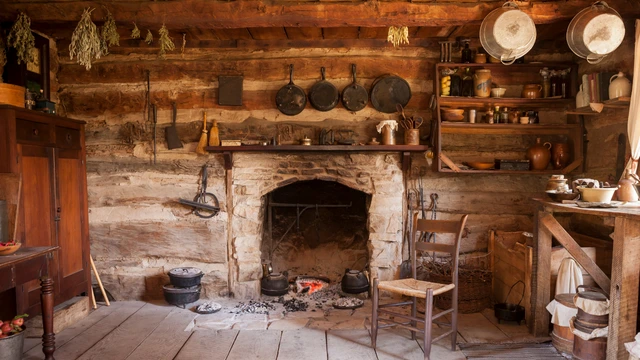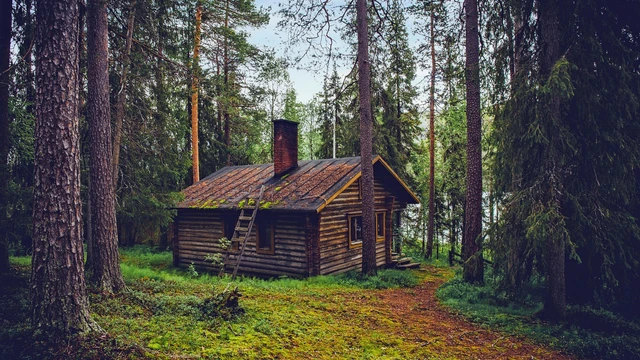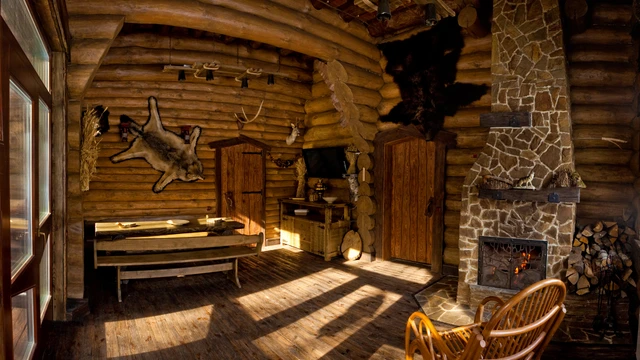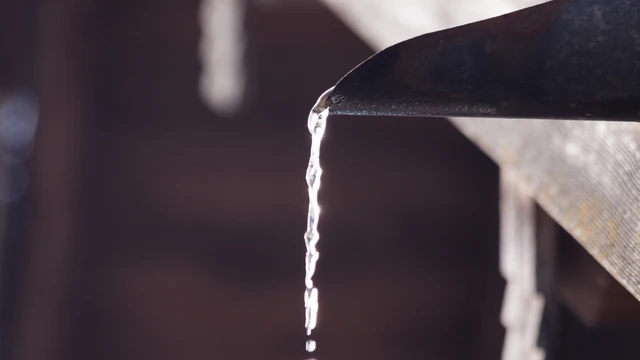What is a Hunting Cabin? The Ultimate Guide
Discover the perfect haven for the ultimate hunting adventure – learn what a hunting cabin is and how it can make your outdoor experience even better!
A hunting cabin is an ideal sanctuary for any hunter, providing shelter from the elements, storage for equipment and gear, and a comfortable space to rest between days of hunting.
It can be as high-end or as rustic as you’d like, with amenities ranging from wood stoves to tank of gas, kerosene lamps to hidden spaces.
Whether you’re a bow-hunting aficionado or just looking for a place to spend time in nature during hunting season, the perfect hunting cabin awaits.
In this article, we’ll look at what makes a great hunting cabin from everyday life essentials to bug traps so you can create your own personal haven.
What is a Hunting Cabin?
A hunting cabin is a type of lodging that hunters use when they go on hunting trips. It can vary in size, design, and amenities, but they usually provide a comfortable and convenient place to stay in the wilderness.
It can be rented or owned, depending on the preference and budget of the hunter.
Some hunting cabins are simple and rustic, while others are more luxurious and modern. It can offer many benefits for hunters who want to enjoy their hobby and nature without sacrificing comfort and safety.
Types of Hunting Cabins
Here are some of the most popular types:
- Log cabin kits: These DIY kits contain all the materials and instructions you need to build your own log cabin. They can be customized to fit your style and needs. Log cabin kits can range from small and simple to large and luxurious
- Prefab Hunting Cabin: These pre-built cabins can be delivered and assembled on your property. They come in various sizes, designs, and materials. Some of them are made from storage containers, which can be portable and cost-effective
- High-End Hunting Cabin: Hunting cabin plans: These blueprints or guides show you how to design and construct your own cabin from scratch. You can use your materials or buy them from a supplier. It can be more flexible and creative than prefab or kit cabins.
Check out this topic to learn about the 7 Essential log cabin tools.
What Are The Essential Features Of A Hunting Cabin?

A hunting cabin is a small, rustic structure designed for hunters to use as a basecamp during hunting trips. It typically contains several basic components that are essential for a comfortable and functional hunting experience. These components may include:
- Small kitchen: A hunting cabin may have a basic kitchen area that includes a stove, sink, and refrigerator to prepare and store food. This is particularly useful for extended hunting trips where access to food is limited.
- Sleeping area: Hunting cabins often have a designated area for sleeping that can accommodate multiple people. This may include bunk beds or cots to maximize the available space.
- Hunting Storage (Gear & Equipment): Hunting cabins typically have storage areas where hunters can store their gear and equipment, such as guns, ammunition, and hunting clothes. This helps to keep the cabin organized and ensures that all necessary items are easily accessible.
- Source of heat: A hunting cabin may have a wood stove or other heating source to keep the interior warm and comfortable, particularly during colder months.
A hunting cabin provides hunters with a comfortable and functional space to rest and prepare for their hunting expeditions. By including these basic components, hunters can ensure that they have everything they need for a successful trip.
Related: Pros And Cons Of Log Cabin Homes
Setting up a Hunting Cabin
When setting up a hunting cabin, it’s important to prioritize function and affordability. Here are some examples of how to set up essential features using simple and affordable materials:
- Propane tank: A propane tank can be used for a variety of purposes in a hunting cabin, such as powering a heater or stove. One way to set this up is to use a small propane tank and attach a hose and regulator to it, allowing you to connect it to a propane-powered appliance.
- Stove: A stove is essential for cooking in a hunting cabin, and can be set up using a variety of materials. One affordable option is to use a camping stove, which can be powered by propane or other fuel sources. Another option is to build a simple outdoor brick or cinder block stove, which can be used for cooking as well as heating.
- Wood stove: A wood stove is a great option for heating a hunting cabin, as it can be powered by easily accessible firewood. One affordable way to set this up is to purchase a pre-fabricated wood stove, which can be installed in the cabin and connected to a chimney. Alternatively, a simple DIY wood stove can be constructed using materials like bricks or sheet metal.
- Rubber maid bins: Rubber maid bins can be used for a variety of storage purposes in a hunting cabin, such as storing food, gear, and supplies. To set this up, simply purchase a few large rubber maid bins and label them for easy organization. These bins can be stored under beds or in other out-of-the-way areas to maximize space in the cabin.
How To Choose The Right Location And Size For Your Hunting Cabin?

When choosing where to build or buy a hunting cabin, several important factors must be considered. Here are some key factors to keep in mind:
What Factors to Consider When Choosing the Location
- Accessibility: The location of your hunting cabin should be easily accessible by vehicle, ATV or on foot, depending on your preferred mode of transportation. The ease of access will affect how often you can visit your cabin and hunt in the area.
- Terrain: The terrain of the area should also be considered when building cabins. You’ll want to choose a spot that is level and dry, and away from any potential flooding or water sources.
- Wildlife activity: Before building or buying a hunting cabin, it’s important to research the local wildlife activity in the area. This can help you determine the best location for your cabin, based on factors such as game trails, feeding areas, and bedding areas.
- Weather conditions: The weather in the area can also impact your hunting and cabin-building plans. For example, if you plan to use your hunting cabin during the winter months, you’ll need to ensure that the cabin is well-insulated and equipped with a reliable heating source.
- Legal regulations: Finally, it’s important to research the local building requirements and regulations in the area where you plan to build or buy a hunting cabin. Some areas may have specific rules about the size or type of hunting cabins that are allowed, or require permits before construction can begin. Be sure to do your research before making any decisions.
Tips to Choose the Right Size
When determining the ideal size for your hunting cabin, it is important to consider your needs and preferences. Here are some tips to help you determine the right size:
- Assess your group size: If you hunt with a group, determine how many people will be staying in the cabin. This will give you an idea of how much space you need to accommodate everyone comfortably.
- Consider the amenities you want: Think about what amenities you want in your cabin, such as a kitchen, bathroom, and living space. The more amenities you want, the more space you’ll need.
- Think about storage: You’ll want to have enough space to store your hunting gear, clothing, and other equipment. Make sure to factor in storage space when determining the size of your cabin.
Common sizes for hunting cabins range from around 500 square feet to 1,500 square feet. Here are some common cabin layouts and their advantages and disadvantages:
- Studio layout: This layout consists of one open space that serves as the living room, bedroom, and kitchen. It’s a good option for small groups or individuals who don’t need a lot of space. However, it can feel cramped and doesn’t offer much privacy.
- One-bedroom layout: This layout features a separate bedroom and living area. It’s a good option for couples or small families. However, it may not offer enough space for larger groups.
- Two-bedroom layout: This layout features two separate bedrooms and a living area. It’s a good option for larger groups or families. However, it requires more square footage and can be more expensive.
The ideal size for your hunting cabin will depend on your specific needs and preferences.
Make sure to consider your group size, desired amenities, and storage needs when determining the size and layout of your cabin.
How To Design And Decorate Your Hunting Cabin?

Decorating a hunting cabin can be a tricky and time-consuming task that often involves putting up with different opinions of friends or family members.
That’s why it’s important to have some ideas on what colors, furnishings, and even fabrics will go well with your new property!
In the following, I’ll share with you some of my top tips and ideas on how to design and decorate your perfect hunting getaway without spending too much money or taking too much time out of your busy schedule!
Ideas to Create a Cozy and Inviting Hunting Cabin
To make your hunting cabin more cozy and inviting, you can add some personal touches and rustic elements that match your style and theme. Here are some ideas to consider:
- Design: Start by creating a design plan that reflects your personal style and the overall look and feel you want for your cabin. Consider incorporating natural elements like wood, stone, and leather to create a rustic ambiance.
- Colors: Choose colors that complement the natural surroundings and enhance the cozy feel of the space. Earthy tones like brown, green, and beige work well for a hunting cabin, while pops of red or orange can add warmth and interest.
- Fabrics: Look for fabrics that are durable and easy to clean, but also add comfort and texture to the space. Cozy wool blankets, soft cotton throws, and plush rugs are great choices for a hunting cabin.
- Furniture: Select furniture that is both functional and stylish, with a focus on comfort and durability. Consider adding a plush sofa or comfortable armchairs, a sturdy dining table, and rustic shelving or storage units.
- Lighting: Lighting can play a big role in creating a cozy atmosphere in your hunting cabin. Use a variety of lighting sources, including table lamps, floor lamps, and overhead lighting, to create a warm and inviting glow.
With these ideas in mind, you can create a cozy and inviting hunting cabin that reflects your personal style and enhances your overall hunting experience. Remember to incorporate a variety of designs and elements that make the space feel like a true home away from home.
How to Display your Hunting Trophies and Memorabilia?
I can provide some tips on how to display your hunting trophies and memorabilia while also protecting them from dust and damage:
- Display your trophies on shelves or wall mounts. This will not only showcase your achievements but also create a focal point in your hunting cabin.
- Consider the intricacy of design when displaying your trophies. You may want to use lighting to highlight certain features or angles that add to the beauty and detail of the animal.
- Use glass or acrylic display cases to protect your trophies from dust and damage. These cases can also be a great way to showcase smaller items like arrowheads or antlers.
- If you have items that are particularly valuable or sentimental, consider getting them professionally framed or mounted to protect them from wear and tear.
- Don’t forget about your hunting memorabilia! You can display items like old hunting licenses, maps, and photographs in frames or shadow boxes. This will not only add to the ambiance of your hunting cabin but also provide a historical context for your hunting experiences.
Displaying your hunting trophies and memorabilia in a thoughtful and creative way can be a great way to personalize your hunting cabin and share your love of the outdoors with others.
Tips for Maintaining & Protecting a Hunting Cabin?

With extended use, the hunting cabin can experience lots of wear and tear. Here are some tips for maintaining and protecting your hunting cabin so that you can enjoy it for years to come!
How to Keep your Hunting Cabin Clean and Organized
Keeping your hunting cabin clean and organized is crucial for both your comfort and safety. Here are some simple routines and habits you can follow to achieve this:
- Establish a cleaning schedule: Set aside a specific day or period of time each week to clean and organize your cabin. This will help you stay on top of things and prevent clutter from building up.
- Sweep and vacuum regularly: Use a broom or vacuum to remove dirt, dust, and debris from floors, rugs, and furniture. This will help prevent the accumulation of allergens and pests.
- Use a disinfectant: Use a disinfectant spray or wipes to clean surfaces, such as countertops, tables, and doorknobs, that are frequently touched. This will help eliminate bacteria and viruses that could cause illness.
- Stock up on cleaning supplies: You’ll need basic supplies such as a broom, dustpan, mop, bucket, and cleaning products. Be sure also to have a supply of clean water, as it’s essential for cleaning and sanitizing.
- Dispose of trash properly: Use trash cans with lids to prevent pests from getting into the garbage. Take out the trash regularly, and don’t leave it outside where it could attract animals.
- Use storage solutions: Use bins, shelves, and hooks to keep items organized and out of the way. This will help prevent clutter from accumulating and make it easier to find what you need.
Following these simple routines and habits can keep your hunting cabin clean and organized. Remember always to use clean water when cleaning and sanitizing, as it’s essential for maintaining a safe and healthy environment.
How to Prevent/Fix Common Problems That May Occur in your Hunting Cabin?
Based on my experience, I can provide some tips on how to prevent or fix common problems that may occur in your cabin:
- Water damage: One of the most common problems in hunting cabins is water damage. To prevent this, ensure your cabin has proper drainage and gutter systems, and check for leaks in the roof, walls, or foundation. If you notice any signs of water damage, such as discoloration or mold growth, address it immediately to prevent further damage.
- Gray water: Gray water refers to wastewater from sinks, showers, and washing machines. To prevent gray water from causing damage to your cabin, make sure your cabin has a gray water system in place. This system should include a grey water pipe that carries the wastewater away from the cabin and into a septic tank or other treatment system.
- Pests infestation: Pests such as mice, rats, and insects can cause damage to your hunting cabin and pose health risks. To prevent pests from entering your cabin, seal all openings and cracks, and keep your cabin clean and clutter-free. If you do notice pests, consider using traps or hiring a professional exterminator.
- Fire hazards: Hunting cabins often have wood-burning stoves or fireplaces, which can pose a fire hazard if not used properly. To prevent fires, make sure your chimney is clean and properly maintained, and only burn seasoned wood. Keep a fire extinguisher in the cabin and make sure everyone knows how to use it.
Preventing common problems in your hunting cabin requires proper maintenance and attention to detail. Regularly inspect your cabin for water damage and pests, and take necessary precautions to prevent fire hazards. Install a gray water system with a grey water pipe to properly dispose of wastewater and prevent damage to your cabin.
Conclusion
In conclusion, a hunting cabin can greatly enhance the hunting experience, providing comfort, convenience, and a sense of seclusion in the great outdoors.
If you’re considering investing in a hunting cabin, be sure to do your research and explore your options to find the perfect fit for your needs. And if you already own a hunting cabin, we encourage you to share your thoughts and experiences with others or check out other related articles and on our website.